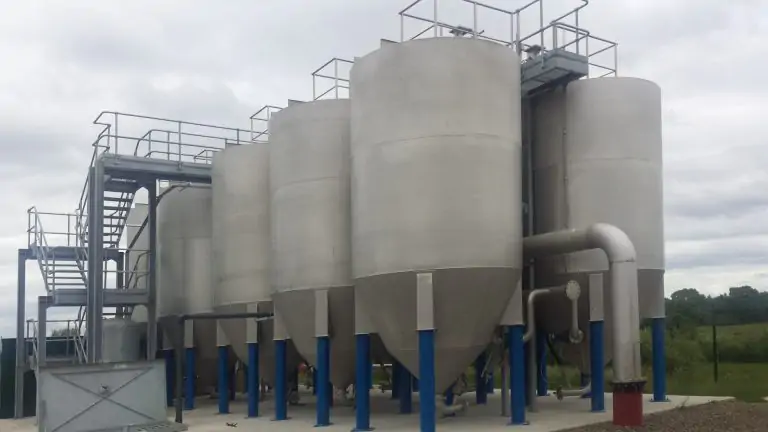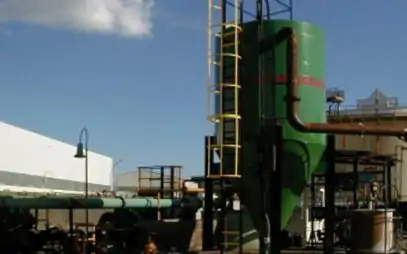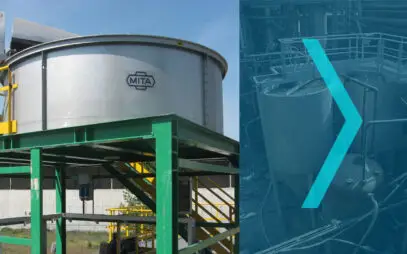High efficiency. Ideal solution for removal of suspended solids, including colloidal solids, at the tertiary filtration level.

FS Sand Filters
For tertiary water treatmentEfficiency and continuity of operation: continuous sand filters represent a classic solution that is easy to construct and operate for wastewater finishing. The MITA solution allows the filter medium, i.e., sand, to be separated from impurities by a unique patented washing system.
Operational continuity. Dirty backwash water exits the filter with continuous flow through a separate drain.
Reduced investment and operating costs. Technology simple to build, install and maintain.
Simplified sand cleaning. External sand recirculation system.
Sustainability. Sand, the medium of filtration, is a natural and therefore environmentally friendly material.
No sand packing. Due to the fluidized-bed filter medium.
Continuous Sand Filters: description and operation
Continuous sand filters are devices used to remove impurities from water through a filtration process.Considering the successive stages in which a civil wastewater plant is composed, this solution operates at the tertiary treatment level, with an output of a few mg/l of total suspended solids. In industrial plants, this technology is often installed downstream of other solutions, to accomplish a final finishing before reintroducing the “blue resource” back into rivers, lakes or seas.
This is the process, in brief.
- The filter is equipped with a system that evenly distributes raw feed water to the base of the sand bed: this by means of an annular distributor.
- The water passes through the sand bed from bottom to top and comes out filtered by a surface weir.
- At the same time, dirty sand is removed from the filter bed by an air pump (airlift), which picks it up from the bottom and lifts it to the top of the filter.
- Here it is fed into a washing chamber (washer), thus preventing the filter bed from becoming packed. Here the removal of impurities from the sand takes place. In the washer, the sand is cleaned by a flow of raw water countercurrent to the gravitational motion of the sand itself.
- The washed sand falls back to the top of the filter bed.
- The dirty wash water leaves the filter with continuous flow through a separate drain.
Sand filters of this type allow continuous and efficient operation. In fact, dirty sand is continuously removed from the filter bed, which is active by the action of an air pump that draws it from the bottom of the filter by lifting it up to the washing chamber.
Ask for InformationCase studies with sand filters
- Industrial Wastewater
- Suspended Solid Removal
- BOD and COD Removal
- Biorulli® Biodiscs
- Continuous Sand Filters
- Oil & Gas
Biodiscs and Sand Filters for Coastal Depots of Esso
MITA Water Technologies provided ESSO Italiana with wastewater treatment solutions at the coastal depots in Naples and Palermo. Through the use of continuous regeneration sand filters and Biorulli(r) biodiscs, significant results were achieved, such as reduced energy consumption and maintenance costs, plant modularity, and compliance with current regulations.
Read more- Industrial Wastewater
- Suspended Solid Removal
- BOD and COD Removal
- Oil and Grease Removal
- Biorulli® Biodiscs
- Dissolved Air Flotation Units
- Continuous Sand Filters
Water Treatment and Cooling Systems for Vedani Group
Various industrial water treatment technologies as well as cooling technologies: since 1995 MITA Water Technologies has provided multiple solutions, together with its "sister" company MITA Cooling Technologies, for the complete water management of Vedani Group, which has been active in aluminum processing since 1982.
Read moreWhat is your process goal?
Tools to help you choose
Industrial and civil wastewater treatment technologies
Our support throughout the product life cycle
A sustainable and efficient solution for every industry and need
Resources
Needs of wastewater treatment
Discover the solution for all needsComparing different technologies
Find out all the different technologiesFind out more
All technical articlesOr You Can Choose
Our Newsletter
Sign up for the MITA Water Technologies newsletter: stay up-to-date on systems for municipal and industrial wastewater treatment and filtration.

